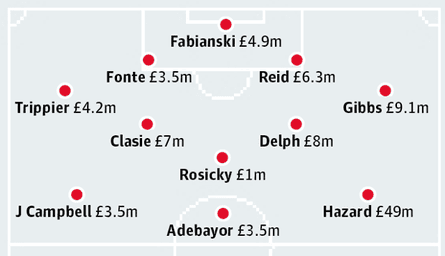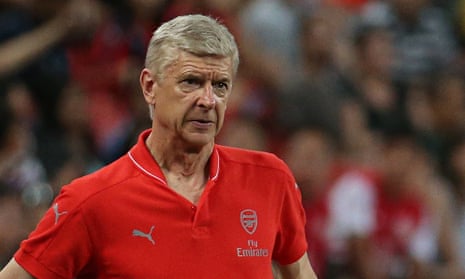The parlour game Arsène Wenger sets in motion with his view on the ever-wacky world of transfers is intriguing. “You want, ideally, a Premier League where every club gets £100m and then let’s see how good you are. It was the case maybe 30 years ago but not that case any more,” the Arsenal manager said in an interview with the Guardian this week.
By doing so the inflated prices that require £49m for a player with 18 Premier League goals in Raheem Sterling might be arrested. More fascinating, though, is how the £100m challenge might prove a leveller. Just as the precise same car for all Formula One drivers would allow the best to shine, so the transfer limit would showcase the best in the Premier League dugouts.
José Mourinho is used to having the kind of war chests available at Chelsea, Real Madrid and Internazionale. Yet the Portuguese’s breakout success was at Porto. There he won the treble of the Primeira Liga, the Taça de Portugal and the Uefa Cup in 2003, and the double of the Primeira Liga and Champions League the following year. This was a team led by Jorge Costa, whom Mourinho recalled from loan at Charlton, and which won the European Cup with Maniche, Paulo Ferreira, Costinha and Nuno Valente. There would be some surprise if Mourinho, whose stellar career was created from bottom up, would not thrive under Wenger’s proposed structure.
Louis van Gaal’s CV offers similar evidence. The triumphant 1995 Champions League Ajax team is heralded for the young (and low cost) guns he harnessed, including Patrick Kluivert, Michael Reiziger, Marc Overmars and Edgar Davids. The Manchester United manager can also point to the four years at AZ Alkmaar, between 2005 and 2009.
There Van Gaal finished second and third in the Eredivisie in his opening two seasons before claiming the Dutch title, against the might of Ajax and PSV Eindhoven, in 2009. Sergio Romero, who moved to Sampdoria in 2011 for £1.5m, Mousa Dembélé, a £5m Fulham acquisition in 2010, and Simon Poulsen, who cost AZ £2.1m, are familiar names. But these are B-list footballers.
How might Brendan Rodgers fare at Liverpool? There might be an argument that, given how the £75m received for Luis Suarez’s sale to Barcelona was invested, the Northern Irishman might struggle with a £100m budget. Rickie Lambert (£4.5m), Adam Lallana (£25m), Dejan Lovren (£20m), Divock Origi (£9.8m), Lazar Markovic (£20m) and the £16m Mario Balotelli have hardly lit Anfield up. Alberto Moreno (£12m) and Emre Can (£9.8m) have fared better. But a strike rate of two from seven might not fill the Fenway Sports Group with confidence should the owners assess if Rodgers could thrive.
Manchester City’s Manuel Pellegrini did impressive work at Villarreal. He led the former to the Champions League semi-finals in 2006 and a club-best second-place La Liga finish in 2007-08 on a budget dwarfed by Real Madrid, Barcelona and the other continental heavyweights. The Chilean achieved similar success at Málaga, taking them into the Champions League for the first time and only two late Borussia Dortmund goalsfrom the semi-finals. Pellegrini may have acquired Sterling for nearly half the £100m sum but this is a function of the bloated market. It underlines Wenger’s point and theory: limit the cash available and fees will tumble.
Southampton’s Ronald Koeman and Swansea City’s Garry Monk should also feel confident of investing the £100m well, given how they took their teams to seventh and eighth respectively, last season. The Saints were touted as relegation favourites after a summer asset strip of Lallana, Calum Chambers, Lovren and Luke Shaw. Yet in came Dusan Tadic for £10.9m, Shane Long (£12m) and Graziano Pelle (£8m) and Koeman returned a fine Premier League finish.
Monk was 33 and had no experience when appointed as interim manager in February 2014 before winning the job permanently at the end of that season. Last term was a first full campaign in charge. Monk lost his best player, Wilfried Bony for £28m to City in the winter window and still sailed serenely on with a squad featuring Lukasz Fabianski (recruited on a free), Jordi Amat (£2.5m), Ashley Williams (£400,000) and Jonjo Shelvey (£5m). Monk was not responsible for all these arrivals or those of others in his squad. Yet his ability to draw impressive displays from all suggests he is a manager in the best sense of the job description.
The same might be claimed elsewhere and everywhere in the league. And, given the challenge was issued by Wenger, the Frenchman would surely back himself to spend the £100m wisely. A counter discourse would be that his stockpiling of attacking midfielders might continue.
But that is the fun of the Wenger hypothetical – the enjoyment of the debate. It will never occur but, if it were to …


Comments (…)
Sign in or create your Guardian account to join the discussion